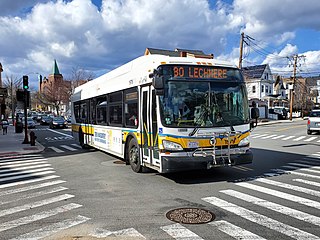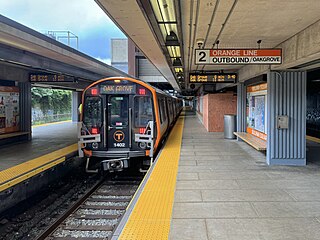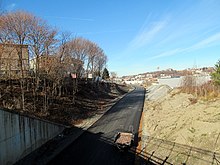
The Silver Line is a system of bus routes in Boston and Chelsea, Massachusetts, operated by the Massachusetts Bay Transportation Authority (MBTA). It is operated as part of the MBTA bus system, but branded as bus rapid transit (BRT) as part of the MBTA subway system. Six routes are operated as part of two disconnected corridors. As of 2023, weekday ridership on the Silver Line was 27,000.

Airport station is a rapid transit station in Boston, Massachusetts. It serves the MBTA Blue Line and the SL3 branch of the Silver Line. It is located in East Boston under the interchange between Interstate 90 and Massachusetts Route 1A. The station provides one of two mass transit connections to the nearby Logan International Airport, as well as serving local residents in East Boston. Shuttle buses connect the station with the airport terminals and other facilities.

Wellington station is a Massachusetts Bay Transportation Authority (MBTA) Orange Line rapid transit station in Medford, Massachusetts, near the border of Everett. It is located on the Revere Beach Parkway, slightly east of its intersection with Route 28. Wellington functions as a park and ride with more than 1,300 spaces, and a bus hub with eight routes terminating at the station. The Station Landing development, connected to the station by an overhead walkway, includes residential and retail buildings and additional parking. Wellington Carhouse, the primary repair and maintenance facility for the Orange Line, is located adjacent to the station.

The Massachusetts Bay Transportation Authority (MBTA) operates 152 bus routes in the Greater Boston area. The MBTA has a policy objective to provide transit service within walking distance for all residents living in areas with population densities greater than 5,000 inhabitants per square mile (1,900/km2) within the MBTA's service district. Much of this service is provided by bus. In 2023, the system had a ridership of 91,459,700, or about 322,600 per weekday as of the third quarter of 2024.

Lechmere station is a Massachusetts Bay Transportation Authority (MBTA) Green Line light rail station in Lechmere Square in East Cambridge, Massachusetts. It is located on the east side of Monsignor O'Brien Highway near First Street, adjacent to the NorthPoint development. The accessible elevated station has a single island platform, with headhouses at both ends. It opened on March 21, 2022, as part of the Green Line Extension (GLX). Lechmere station is served by Green Line D branch and E branch service.

The Massachusetts Bay Transportation Authority (MBTA) operates two specially designated crosstown bus routes in the Boston, Massachusetts, United States area, called CT2 and CT3, and intended as limited-stop buses connecting major points. The two weekday-only routes largely parallel MBTA bus local routes, but with fewer stops to reduce travel times.

Nubian station is a ground-level Massachusetts Bay Transportation Authority (MBTA) bus station located in Nubian Square in the Roxbury neighborhood of Boston, Massachusetts, United States. It is a transfer point between MBTA bus routes, including two Silver Line bus rapid transit lines and 14 local routes. Like all MBTA bus stops, Nubian is fully accessible.

Sullivan Square station is a rapid transit station on the MBTA subway Orange Line, located adjacent to Sullivan Square in the Charlestown neighborhood of Boston, Massachusetts. It is a major transfer point for MBTA bus service, with 10 routes using a two-level busway. The station has two island platforms serving the two active Orange Line tracks plus an unused third track. The Haverhill Line and Newburyport/Rockport Line pass through the station on separate tracks but do not stop.

World Trade Center station is an underground bus rapid transit station on the MBTA's Silver Line, located south of Congress Street on the South Boston Waterfront. The station is situated between the World Trade Center and the Boston Convention and Exhibition Center; it also serves Commonwealth Pier and nearby residential and commercial development. Like all Silver Line stations, World Trade Center station is accessible.

Fenway station is a light rail stop on the MBTA Green Line D branch, located under Park Drive near the Riverway in the Fenway–Kenmore neighborhood of Boston, Massachusetts. It opened as Fenway Park along with the rest of the D branch on July 4, 1959, when streetcars replaced Highland branch commuter rail service. The station is fully accessible from Park Drive via the Landmark Center parking lot, as well as from Miner Street. Now named after the Fenway neighborhood rather than Fenway Park, it is slightly further from the stadium than Kenmore, though still heavily used during events.

Bellingham Square station is a Massachusetts Bay Transportation Authority (MBTA) Silver Line bus rapid transit (BRT) station located near Bellingham Square slightly north of downtown Chelsea, Massachusetts. The station has two accessible side platforms for buses on the SL3 route. The Boston and Maine Railroad and predecessor Eastern Railroad served Chelsea station at the same location from the mid-1850s to 1958. The MBTA opened Chelsea station on the Newburyport/Rockport Line in 1985. Prior to its 2010 cancellation, the Urban Ring Project planned for a circumferential BRT line with a stop at Mystic Mall. Planning continued for the Chelsea segment; a Silver Line extension to Mystic Mall was announced in 2013. Construction began in 2015, and SL3 service to the renamed Bellingham Square station began on April 21, 2018. Commuter rail service moved to the newly constructed Chelsea station on November 15, 2021.

Melnea Cass Boulevard station is a street-level bus station on the Washington Street branch of the MBTA Silver Line bus rapid transit service. It is located on Washington Street at Melnea Cass Boulevard in the Roxbury neighborhood of Boston, Massachusetts. The stop is served by the SL4 and SL5 Silver Line routes; several local MBTA bus routes stop nearby. Like all Silver Line stops, Melnea Cass Boulevard is accessible.

The Green Line Extension (GLX) was a construction project to extend the Massachusetts Bay Transportation Authority (MBTA) Green Line light rail system northwest into Somerville and Medford, two inner suburbs of Boston, Massachusetts. The project opened in two phases in 2022 at a total cost of $2.28 billion. Total ridership on the 4.3-mile (6.9 km) extension is estimated to reach 45,000 one-way trips per day in 2030.

Boston University Central station is a surface-level light rail station on the MBTA Green Line B branch, located the center median of Commonwealth Avenue west of St. Marys Street in Boston, Massachusetts, surrounded by the Boston University campus. It consists of two side platforms, which serve the B branch's two tracks. The station is accessible, with raised platforms to allow level boarding onto low-floor trams and a high platform on the inbound side to serve high-floor light rail vehicles.

Assembly station is a rapid transit station in Somerville, Massachusetts. It serves the MBTA's Orange Line. It is an infill station, located on a section of the Orange Line that has been active since 1975. The station, which opened on September 2, 2014, was the first new rail station on the MBTA subway system since 1987. Assembly station is meant to provide convenient access to Assembly Square - a major retail and residential development located on the site of a former Ford assembly plant - and the adjacent Assembly Square Marketplace.

Newmarket station is an MBTA Commuter Rail station in Boston, Massachusetts. It serves the Fairmount Line and a small number of Franklin/Foxboro Line trains. It is located off Massachusetts Avenue at Newmarket Square in the Dorchester neighborhood. The station has two 800-foot (240 m) high-level platforms and sloping walkways connecting it to Massachusetts Avenue. Originally planned to be in service in 2011, it opened on July 1, 2013, along with Four Corners/Geneva station.

Gilman Square station is a light rail station on the Massachusetts Bay Transportation Authority (MBTA) Green Line located at Gilman Square in Somerville, Massachusetts. The accessible station has a single island platform serving the two tracks of the Medford Branch. It opened on December 12, 2022, as part of the Green Line Extension (GLX), which added two northern branches to the Green Line, and is served by the E branch.

Chelsea station is a Massachusetts Bay Transportation Authority (MBTA) intermodal transit station located adjacent to the Mystic Mall in Chelsea, Massachusetts. It is the terminus of the SL3 route of the MBTA Silver Line bus rapid transit (BRT) network, and is served by the Newburyport/Rockport Line of the MBTA Commuter Rail. The accessible station has a loop with two small platforms for the Silver Line, and two full-length side platforms for commuter rail trains.

Box District station is a bus rapid transit station on the Massachusetts Bay Transportation Authority (MBTA) Silver Line system, located in Chelsea, Massachusetts. The accessible station has two side platforms under an arched canopy, with street access from Broadway and from Highland Street. Plans for the Urban Ring Project called for a busway along the former Grand Junction Branch, but without a station in the Box District neighborhood. After the Urban Ring was cancelled in 2010, new plans for a busway with a Box District stop were announced in 2013. Construction began in 2015, with route SL3 service beginning on April 21, 2018.

Eastern Avenue station is a bus rapid transit station on the Massachusetts Bay Transportation Authority (MBTA) Silver Line system, located in Chelsea, Massachusetts near Chelsea Creek. The accessible station has two side platforms, with street access from Eastern Avenue and Central Avenue. Plans for the Urban Ring Project called for a busway along the former Grand Junction Branch, but with a station further north at Griffin Way. After the Urban Ring was cancelled in 2010, new plans for a busway with an Eastern Avenue stop were announced in 2013. Construction began in 2015, with route SL3 service beginning on April 21, 2018.






















